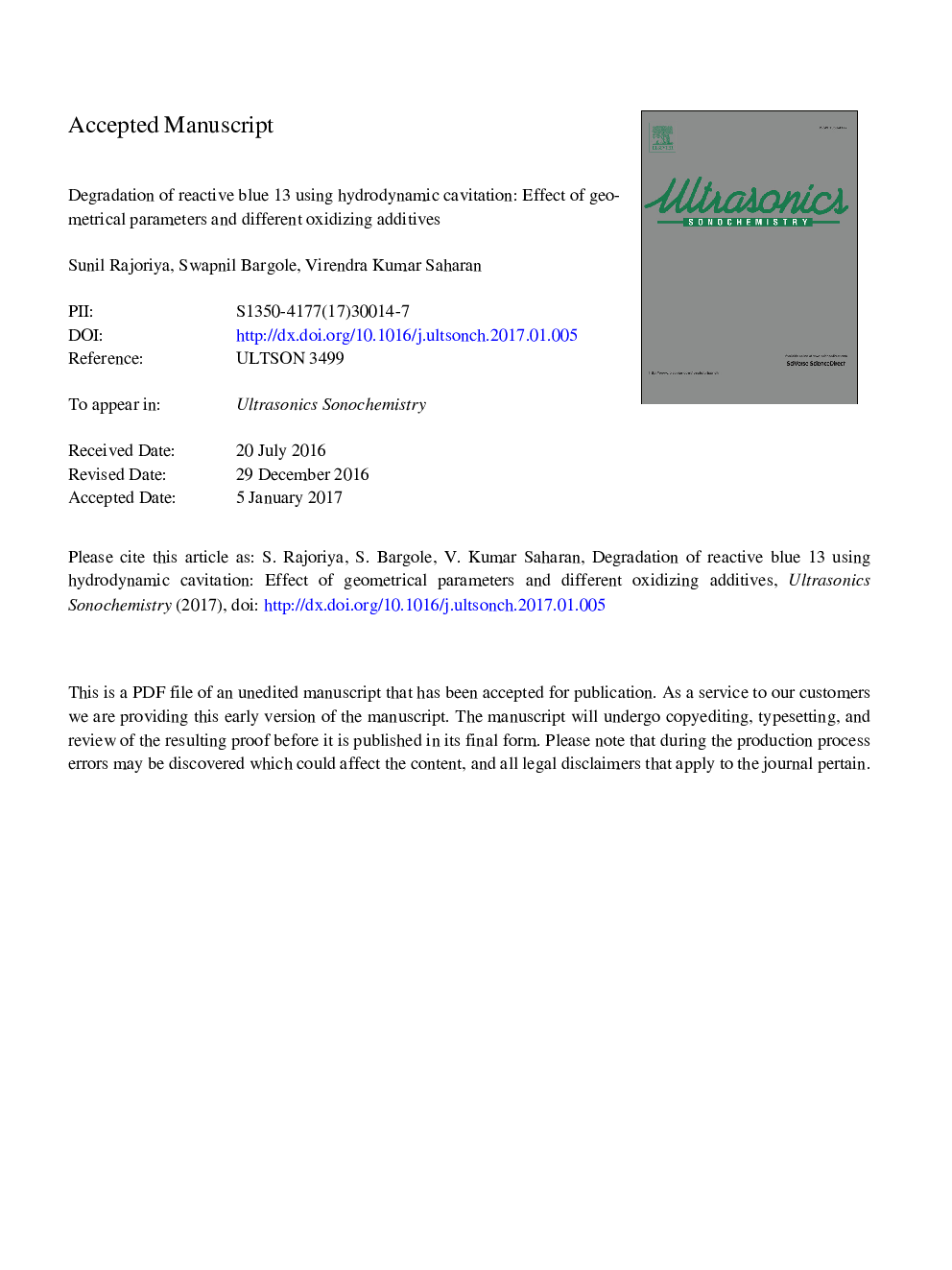| کد مقاله | کد نشریه | سال انتشار | مقاله انگلیسی | نسخه تمام متن |
|---|---|---|---|---|
| 5144803 | 1496868 | 2017 | 44 صفحه PDF | دانلود رایگان |
عنوان انگلیسی مقاله ISI
Degradation of reactive blue 13 using hydrodynamic cavitation: Effect of geometrical parameters and different oxidizing additives
دانلود مقاله + سفارش ترجمه
دانلود مقاله ISI انگلیسی
رایگان برای ایرانیان
موضوعات مرتبط
مهندسی و علوم پایه
شیمی
شیمی (عمومی)
پیش نمایش صفحه اول مقاله

چکیده انگلیسی
Decolorization of reactive blue 13 (RB13), a sulphonated azo dye, was investigated using hydrodynamic cavitation (HC). The aim of research article is to check the influence of geometrical parameters (total flow area, the ratio of throat perimeter to its cross-sectional area, throat shape and size, etc.) and configuration of the cavitating devices on decolorization of RB13 in aqueous solution. For this purpose, eight cavitating devices i.e. Circular and slit venturi, and six orifice plates having different flow area and perimeter were used in the present work. Initially, the effects of various operating parameters such as solution pH, initial dye concentration, operating inlet pressure and cavitation number on the decolorization of RB13 have been investigated, and the optimum operating conditions were found. Kinetic analysis revealed that the decolorization and mineralization of RB13 using HC followed first order reaction kinetics. Almost 47% decolorization of RB13 was achieved using only HC with slit venturi as a cavitating device at an optimum inlet pressure of 0.4 MPa and pH of the solution as 2.0. It has been found that in case of orifice plates, higher decolorization rate of 4 Ã 10â3 minâ1 was achieved using orifice plate 2 (OP2) which is having higher flow area and perimeter (α = 2.28). The effect of process intensifying agents (hydrogen peroxide and ferrous sulphate) and different gaseous additives (oxygen and ozone) on the extent of decolorization of RB13 were also examined. Almost 66% decolorization of RB13 was achieved using HC combined with 2 L minâ1 of oxygen and in combination with ferrous sulphate (1:3). Nearly 91% decolorization was achieved using HC combined with H2O2 at an optimum molar ratio (dye:H2O2) of 1:20 while almost complete decolorization was observed in 15 min using a combination of HC and ozone at 3 g hâ1 ozone feed rate. Maximum 72% TOC was removed using HC coupled with 3 g hâ1 ozone feed rate.
ناشر
Database: Elsevier - ScienceDirect (ساینس دایرکت)
Journal: Ultrasonics Sonochemistry - Volume 37, July 2017, Pages 192-202
Journal: Ultrasonics Sonochemistry - Volume 37, July 2017, Pages 192-202
نویسندگان
Sunil Rajoriya, Swapnil Bargole, Virendra Kumar Saharan,